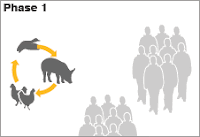
Nurse taking swab test
Health protection officials are still trying to contain flu in the UK
The headlines have been impossible to miss - swine flu has reached pandemic proportions.
But once the dust settles on the World Health Organization announcement, what will it actually mean?
Technically a pandemic is when community-wide human-to-human transmission is being seen in two regions of the world.
But that does not mean the world is going to see the spread of the disease on the scale of the 1918 Spanish Flu which claimed the lives of 50m people.
In many respects, phase six - as the pandemic stage is classed by the WHO - is just a label.
Struggle
What really matters is what individual countries are doing on the ground to tackle the disease - and that is not dictated by WHO but determined by national governments.
The announcement will not make any difference to the developing countries across the world that are struggling to implement their plans because of the lack of resources.
And in Australia, the country that tipped the balance from phase five to six, the fight continues along the same lines as it has in recent weeks.
WHO PANDEMIC ALERT PHASES
Flu viruses in different species
Phase 1: No infections in humans are being caused by viruses circulating in animals.
Flu virus mutation
Phase 2: Animal flu virus causes infection in humans, and is a potential pandemic threat.
Antigenic shift in pigs
Phase 3: Flu causes sporadic cases in people, but no significant human-to-human transmission.
Virus transmission to humans
Phase 4: Human-to-human transmission and community-level outbreaks.
Virus transmission to humans
Phase 5: Human-to-human transmission in at least two countries. Strong signal pandemic imminent.
Virus transmission to humans
Phase 6: Virus spreads to another country in a different region. Global pandemic under way.
Virus transmission to humans
Post-peak: Pandemic activity appears to be decreasing though second wave possible.
Post-pandemic: activity returns to normal, seasonal flu levels.
BACK {current} of {total} NEXT
Nor does the announcement alter the approach the UK is taking in its battle to contain the virus, which has infected more than 700 so far.
"It is irrelevant," says Professor Steve Field, president of the Royal College of GPs, which worked with the government to develop the flu contingency plans.
"What really matters is what is happening in places like Birmingham where flu has spread.
"The approach being taken here has been about containing the disease.
"It is largely working so far, but things can change very quickly."
Alert
The UK has four levels of alert for a pandemic with the current situation most closely resembling level three, defined as "outbreaks within the UK".
However, what is more important is what experts are calling the shift away from containment.
Ever since outbreaks started to be seen in the UK, health protection officials have been following a fairly standard protocol of giving anti-virals, isolating cases and tracing their contacts.
UK ALERT LEVELS
One - Virus only seen outside the UK
Two - Virus isolated in the UK
Three - Outbreaks in the UK
Four - Widespread activity across the UK
This has also led to the closure of several schools.
But if the UK problem reaches what is called the mitigation stage - whereby the disease is spreading but there are still no vaccine to protect people - then a different approach is required.
This could involve everything from placing restrictions on public gatherings, such as football matches and concerts, to limiting the use of drugs.
In practice, this would mean giving drugs only to those who have got the disease rather than as a preventative measure to people they have come into contact with.
The flu plans also contain contingencies to stop routine NHS operations to allow hospitals to cope with a flood of flu patients.
The government's emergency planning group Cobra has already discussed such steps, but it is by no means a foregone conclusion that they will be enacted in the immediate future.
Instead, the government is remaining tight-lipped over future developments.
There is concern that the virus might mutate in the southern hemisphere over its winter and become more virulent, but there's no sign of that yet
Fergus Walsh
BBC's medical correspondent
Read Fergus's thoughts in full
Global view
The Department of Health says: "The WHO alert levels reflect the global view, and any action taken in the UK will be based on the situation here.
"We are monitoring the situation constantly and if anything changes we will react accordingly."
Professor Paul Hunter, a health protection expert at the University of East Anglia, says if anything the political consequences of the first pandemic in more than 40 years will be greater than any operational shift.
"There will be debates in Parliament, people will get worried and we will have to see how businesses and politicians react.
"There is a risk that there will be panic and calls for travel restrictions and the like.
"So far the government has got the reaction right in my view.
"And while it is worrying we are still seeing cases despite it being summer when flu generally does not spread, we can still be reassured that it is a relatively mild disease."
Indeed, that in many ways is the key.
The word pandemic sounds serious, but it just refers to its geographical spread not how virulent it is.
While the disease has spread to more than 70 countries, infecting nearly 30,000 people in the process, the death toll at 140 has been relatively small.
Subscribe to:
Post Comments (Atom)

0 komentar:
Post a Comment